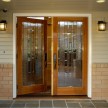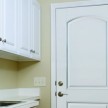Insulated Garage Doors
Lower Energy Costs and Improve the Comfort of Your Home Year-Round with an Insulated Garage Door
A leaky, uninsulated garage door may not be an obvious culprit in rising monthly utility bills, but it’s worth a second look if you have an attached garage.
Replacing an older garage door with a new, energy efficient model can reduce energy loss through the garage by up to 71%, according to a comparison study conducted by engineers at Clopay Building Products, the nation’s leading manufacturer of residential garage doors.
“Since attached garages typically share one or two common walls with the house, any hot or cold that travels through a door will ultimately affect the adjacent living areas,” says Mark Westerfield P.E., Director of Product Development for Clopay. “An insulated garage door can help stabilize temperatures in the garage to reduce heat losses or gains.”
Depending on the specifics of the home, a well insulated door can help keep an unheated garage 10 to 20 degrees warmer on a cold winter day. “That can have a significant impact on the comfort of family rooms or bedrooms located above or next to the garage,” adds Westerfield.
More than 40 percent of the current housing stock was built prior to the era of energy efficiency. If your garage door is a holdover from the dark ages, here are some things to consider when making an upgrade:
Budget. Like everything, budget dictates options. Garage doors range in price from a few hundred to several thousand dollars depending on the size, material and design you choose.
In the hierarchy of good, better, best, when it comes to garage door durability and energy efficiency, a two inch, three-layer ”sandwich” construction ranks at the top. These doors have environmentally safe insulation layered between two sheets of heavy-duty galvanized steel.
R-value or U-factor. The higher the R-value, or the lower the U-factor, the more energy efficient the insulation is.
Insulation type. There are two different types of insulation used in garage doors: expanded polystyrene and polyurethane. Polyurethane insulation delivers twice the thermal performance of polystyrene insulation of the same thickness. Doors constructed from either kind are strong and durable.
Low-E (Low Emissivity) insulated glass. Available on certain door models, Low-E glass has a special coating that reduces the amount of infrared radiation that passes through, to reduce the overall heat transfer through the glass and improve energy efficiency. Due to the special coating, the glass has a slight greenish hue.
Upkeep. Maintenance is another consideration. Steel doors are very durable and virtually maintenance-free, but some people prefer the warmth and character of wood. and the limitless design options. Depending on the climate and exposure, wood doors will need to be painted or stained every few years.
Building Code Requirements. If you live in a coastal region you may be required to install a reinforced door. Because of their size, garage doors are more susceptible to wind damage than other exterior openings – especially two-car garage doors. High winds can force it out of the opening, putting your home and property at risk.
Design – Your garage door has a significant impact on the look of your home, especially if it faces the street. Choose a model that complements exterior design features like window shapes, finishes and materials.
Manufacturers like Clopay offer a free design tool on their web site that lets you upload a digital photo of your home to try on various door styles until you find the perfect match.
Clopay is also the only garage door manufacturer that offers fiberglass entry doors to complement their garage door designs. The result is spectacular coordinated curb appeal.
The Lowdown on Door Construction Materials
Today homeowners can choose between wood, steel, composite or aluminum garage doors.
Wood: There’s no substitute for the warm, distinctive look of wood. It offers the most design flexibility to create a one-of-a-kind door, and the species and stain options are endless. Depending on the climate and exposure, wood doors require more finish maintenance.
Composite and steel: Steel doors with composite overlays offer the benefits of durable, insulated steel with added charm and design flexibility. Details like coped edging, true divided lites and a wood grain surface texture that can be painted or stained make it an attractive, low-maintenance alternative to real wood.
Steel: These doors offer the broadest range of insulation and price options from as little as few hundred dollars for a single-layer, non-insulated door, up to a few thousand for a premium three-layer sandwich door featuring 2” thick insulation and a decorative design.
Aluminum: Rust-proof and corrosion resistant, this material is ideal for humid, caustic environments as well as coastal areas. And it’s incredibly durable.








